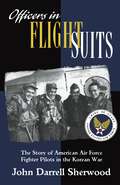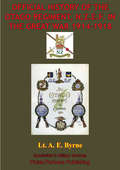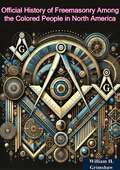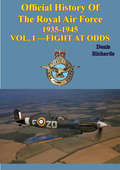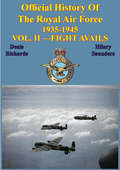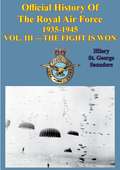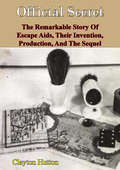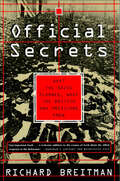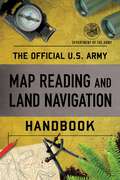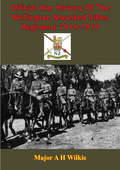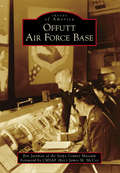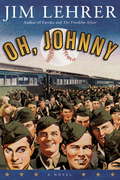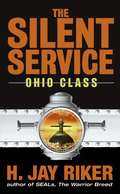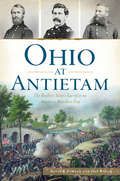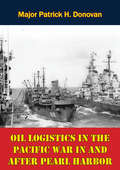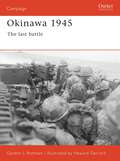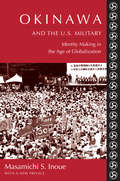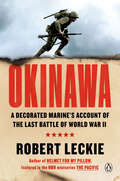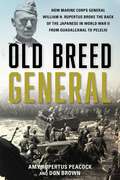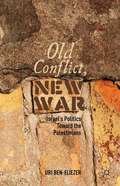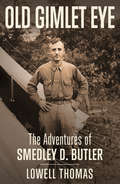- Table View
- List View
Officers in Flight Suits: The Story of American Air Force Fighter Pilots in the Korean War
by John Darrell SherwoodSherwood recounts the story of American Air Force pilots in the Korean War and the development of a lasting fighter-pilot cultureThe United States Air Force fought as a truly independent service for the first time during the Korean War. Ruling the skies in many celebrated aerial battles, even against the advanced Soviet MiG-15, American fighter pilots reigned supreme. Yet they also destroyed virtually every major town and city in North Korea, demolished its entire crop irrigation system and killed close to one million civilians. The self-confidence and willingness to take risks which defined the lives of these men became a trademark of the fighter pilot culture, what author John Darrell Sherwood here refers to as the flight suit attitude. In Officers in Flight Suits, John Darrell Sherwood takes a closer look at the flight suit officer's life by drawing on memoirs, diaries, letters, novels, unit records, and personal papers as well as interviews with over fifty veterans who served in the Air Force in Korea. Tracing their lives from their training to the flight suit culture they developed, the author demonstrates how their unique lifestyle affected their performance in battle and their attitudes toward others, particularly women, in their off-duty activities.
Official History Of The Otago Regiment In The Great War 1914-1918 [Illustrated Edition]
by Lieutenant A. E. ByrneContains over 55 photos and 10 maps."The record of a New Zealand infantry regiment in Egypt, at Gallipoli and on the Western Front, from formation to disbandment....When the force sailed on 14 October 1914, the embarkation strength of the Otago Battalion was 34 officers and 1,076 other ranks....In April 1915 the division sailed for Gallipoli via Mudros, and on the 25th of that month the Otago Battalion landed with the brigade near Anzac Cove. The battalion was eight months at Gallipoli, fighting in several actions, particularly the second battle of Krithia and the battle of Sari Bair. It was evacuated in December 1915 and returned to Egypt where a 2nd Battalion was formed for each of the four original battalions and the combined New Zealand and Australian Division was reorganized as an all New Zealand Division which crossed to France in April 1916...On the Western Front the New Zealand Division was an elite formation and the regiment was involved in most of the major operations - the Somme, Messines, Third Ypres and the battles of 1918. Two VCs were won including one of the most famous, that awarded to Sgt Travis (real name Savage) of the 2nd Battalion, known as the king of No Man's Land, who was killed in Rossignol Wood in July 1918 and is buried in Couin New British Cemetery; the divisional commander attended his funeral. He gets a chapter to himself in the book. This is a good, authoritative history as the title suggests, in which personalities are identified in the narrative, casualty figures and reinforcements noted; minor actions are described as well as the bigger picture."--N&M Print ed.
Official History of Freemasonry Among the Colored People in North America: ; C. 1
by William H. GrimshawOfficial History of Freemasonry Among the Colored People in North America by William H. Grimshaw is a seminal work that chronicles the rich and often overlooked history of African American Freemasonry. This comprehensive volume delves into the origins, development, and significant contributions of Black Freemasons in North America, offering an authoritative account that is both informative and inspiring.William H. Grimshaw, a prominent Freemason and historian, meticulously traces the roots of African American Freemasonry back to its earliest beginnings. He highlights key figures, lodges, and pivotal events that shaped the Masonic tradition among Black communities. The book provides detailed biographies of influential leaders and examines their roles in promoting social justice, education, and community solidarity.Grimshaw’s narrative goes beyond mere historical facts, offering a profound exploration of the cultural and social impact of Freemasonry on African American life. He discusses the challenges and triumphs faced by Black Masons, including their efforts to gain recognition and respect within the broader Masonic fraternity and society at large. The book also sheds light on the philosophical and moral tenets that underpin Freemasonry, illustrating how these principles guided the actions and beliefs of its members.Official History of Freemasonry Among the Colored People in North America is richly supplemented with primary documents, personal testimonies, and archival materials, making it an invaluable resource for historians, scholars, and anyone interested in the intersection of African American history and fraternal organizations. Grimshaw’s work is a testament to the resilience and dedication of Black Freemasons who, despite facing significant obstacles, made enduring contributions to their communities and the nation.This book is an essential read for those seeking to understand the broader narrative of American Freemasonry and the vital role played by African Americans in this storied tradition. Through Grimshaw’s thorough research and engaging prose, readers are offered a window into a vibrant and dynamic chapter of North American history, celebrating the legacy and ongoing influence of African American Freemasonry.
Official History of the Royal Air Force 1935-1945 — Vol. I —Fight at Odds [Illustrated Edition] (Official History of the Royal Air Force 1935-1945 #1)
by Denis RichardsIncludes, 21 maps/diagrams and 17 Illustrations/photosThe Royal Air Force is the oldest independent air force in the world, having gained its spurs over the trenches of Flanders in the First World War it was officially established in 1918. However it was during the Second World War that it would achieve its greatest successes yet, from an inauspicious start following post war budget cuts it would rise to become a decisive factor in the campaign to remove the Nazis from Europe and the Japanese from mainland Asia. The three volume Official History gives a sound and broad narrative of all of the campaigns, actions and engagements that the Royal Air Force was party to across Europe, Asia, Africa and Australasia. The text was set out in manageable chapters, each dealing with a particular episode of the struggle against Fascism; and is written in an easy and accessible style free from the specialised vocabulary of flying or aerial combat.The first volume covers the period - 1939-1942; including The Initial Phoney War period.The Norway ExpeditionThe Battle of FranceThe Battle of BritainThe BlitzThe opening stages of the Battle of the AtlanticThe opening stages of the North African Campaign.
Official History of the Royal Air Force 1935-1945 — Vol. II —Fight Avails [Illustrated Edition] (Official History of the Royal Air Force 1935-1945 #2)
by Denis Richards Hilary SaundersIncludes, 20 maps/diagrams and 23 Illustrations/photosThe Royal Air Force is the oldest independent air force in the world, having gained its spurs over the trenches of Flanders in the First World War it was officially established in 1918. However it was during the Second World War that it would achieve its greatest successes yet, from an inauspicious start following post war budget cuts it would rise to become a decisive factor in the campaign to remove the Nazis from Europe and the Japanese from mainland Asia. The three volume Official History gives a sound and broad narrative of all of the campaigns, actions and engagements that the Royal Air Force was party to across Europe, Asia, Africa and Australasia. The text was set out in manageable chapters, each dealing with a particular episode of the struggle against Fascism; and is written in an easy and accessible style free from the specialised vocabulary of flying or aerial combat.This second volume covers the period - 1941-1944, includingThe Fall of BurmaThe CapitulationThe Continuing struggle during the Battle of the AtlanticThe Victory in the North African CampaignThe Capture of SicilyThe Battle of Monte Cassino and the Fall of RomeThe Bombing campaign against Germany gains momentum
Official History of the Royal Air Force 1935-1945 — Vol. III —Fight is Won[Illustrated Edition] (Official History of the Royal Air Force 1935-1945 #3)
by Hilary SaundersIncludes, 21 maps/diagrams and 23 Illustrations/photosThe Royal Air Force is the oldest independent air force in the world, having gained its spurs over the trenches of Flanders in the First World War it was officially established in 1918. However it was during the Second World War that it would achieve its greatest successes yet, from an inauspicious start following post war budget cuts it would rise to become a decisive factor in the campaign to remove the Nazis from Europe and the Japanese from mainland Asia. The three volume Official History gives a sound and broad narrative of all of the campaigns, actions and engagements that the Royal Air Force was party to across Europe, Asia, Africa and Australasia. The text was set out in manageable chapters, each dealing with a particular episode of the struggle against Fascism; and is written in an easy and accessible style free from the specialised vocabulary of flying or aerial combat.This third volume covers the period - 1943-1945The end of the U-Boat menace in the AtlanticThe Normandy LandingsThe Battle for FranceOperations Market-Garden and the 'Bridge Too Far'The Recapture of Burma and the battles of Kohima and ImphalThe campaign against the V1 and V2 rocketsFinal Victory
Official Secret: The Remarkable Story Of Escape Aids, Their Invention, Production, And The Sequel
by Clayton HuttonFew readers fail to thrill to escape stories, but do they pause to wonder who or what organization was behind the ingenious escape aids that became familiar to the allied forces. Here is the story of that man, Major Hutton. whose wartime job was to devise aids to facilitate production, to engineer distribution and to be ready to substitute at one when the enemy solved the secret. There were silk maps to all areas and frontiers; there were all sorts of ways of concealing tiny compasses; there were flying books that could be quickly converted, heels that held money, plastic containers that held necessities for survival - food, medicine first aid items, even a cream in toothpaste tubes. Frequently his methods were on the edge of the illegal.—Print Ed.
Official Secrets: What the Nazis Planned, What the British and Americans Knew
by Richard BreitmanRichard Breitman's Official Secrets is an important work based on newly declassified archives.As defeat loomed over the Third Reich in 1945, its officials tried to destroy the physical and documentary evidence about the Nazis' monstrous crimes, about their murder of millions. Great Britain already had some of the evidence, however, for its intelligence services had for years been intercepting, decoding, and analyzing German police radio messages and SS ones, too. Yet these important papers were sealed away as "Most Secret," "Never to Be Removed from This Office"-and they have only now reappeared. Integrating this new evidence with other sources, Richard Breitman reconsiders how Germany's leaders brought about the Holocaust-and when-and reassesses Britain's and America's suppression of information about the Nazi killings. His absorbing account of the tensions between the two powers and the consequences of keeping this information secret for so long shows us the danger of continued government secrecy, which serves none of us well, and the failure to punish many known war criminals.
Official U.S. Army Map Reading and Land Navigation Handbook
by Department of the ArmyThe U.S. Army&’s official guide to map reading, determining location, and navigatingFor a soldier, knowing where you are is a matter of life and death, and so it comes as no surprise that the Army has produced the most complete, clear, and thorough guide to map reading and navigation available.The book starts with a comprehensive explanation of the meaning and uses of maps, whether photographic, planimetric (standard-style), or topographic, then proceeds to the use of those maps, discussing compass techniques, celestial navigation, and determination of distance. There is a detailed section on interpreting topographic maps, with notes on tactical considerations for differing terrain, as well as determining the ease of movement through an area. The book&’s crucial, well-illustrated chapters have invaluable information on:Training StrategyMapsMarginal Information and SymbolsGridsScale and Distance Direction OverlaysAerial PhotographsNavigation Equipment and MethodsElevation ReliefTerrain AssociationMounted Land NavigationNavigation in Different Types of TerrainUnit SustainmentThere is also information on field sketching, the tricky art of map folding, units of measure and conversion factors, map symbols, orienteering, and the global positioning system (GPS).
Official War History Of The Wellington Mounted Rifles Regiment 1914-1919 [Illustrated Edition]
by Major A H WilkieIllustrated with over 40 photos and 10 maps"Official history of a NZ Regiment which saw service in the Middle East in the Great War.The Regiment was established in 1911, but this book deals solely with its WWI services - Egypt, Gallipoli and Palestine (Gaza, Beersheba, Jerusalem, Jordan). The narrative is clear and informative, with plenty of detail and with many individuals mentioned by name (especially casualties). Apps: Roll of Honour (KIA and WIA, Gallipoli and Palestine), H & A, List of COs.--N&M Print Version
Offshore Ferry Services of England & Scotland: A Useful Guide to the Shipping Lines and Routes
by Peter C. SmithThe United Kingdom comprises thousands of islands and for many centuries transport between the main islands and the outlying communities has required reliable shipping routes, both long and short-haul, for commerce, trade and travel. Ferries have become an essential means of transport for many outlying populations and down the years routes have continually changed and been adapted to meet the requirements of the period. This remains so today, with established ferry routes in a constant state of flux, with the dire economic circumstances of the present imposing their own financial restraints upon routes and timetables. This volume presents a snapshot of the major Offshore Ferry routes as they currently stand, with details of the routes, the ships and the amenities; added to which are the outline histories of companies and links. This volume encapsulates all these strands and should prove a useful aide to all travellers.
Offutt Air Force Base (Images of America)
by Ben Justman Cmsaf Ret. MccoyThe year is 1888, and Pres. Grover Cleveland has just signed into law a bill that will lead to the establishment of Fort Crook. In 1948, that Army post gained a new name: Offutt Air Force Base. The history of Offutt Air Force Base is truly unlike that of any other military installation. In the face of adversity, it has overcome challenges during the United States' rise to global prominence, was active during the golden age of flight, and served as a wartime bomber plant. The base remained ever vigilant during the Cold War and continues to do so as a combatant of 21st-century threats. Its remarkable existence of nearly 125 years can serve as a road map of US history. Today, the 55th Wing serves as the host unit for Offutt Air Force Base; its motto, "Videmus Omnia" ("We See All"), can also be applied to the saga of the base.
Oh, Johnny
by Jim LehrerA talented athlete, Johnny Wrigley believes that someday he will play major league baseball. But his life unexpectedly takes a detour. In April 1944, Johnny is a newly minted marine on a troop train heading west for California, where he will be shipped overseas to fight in the Pacific Theater. At a brief stop in Wichita, Johnny gets off the train and falls in love with the most beautiful girl he has ever seen. In a storeroom at the station, they share an intimacy that Johnny will treasure for the next two years at war--and beyond.In Peleliu and Okinawa, nothing prepares Johnny for the terrible events that will haunt him forever. During fierce combat, inspiring thoughts of Betsy Luck (the name Johnny has given his Kansas love) keep him safe. Two years later, Johnny is back in Wichita, searching for the girl he wants to marry. But fate has different plans for Johnny, his long-dreamed-of baseball career, and the girl whose memory helped him survive.
Ohio Class (Silent Service Series #5)
by H. Jay RikerThe New War The face of the enemy has changed. His weapon is terror; his target is the innocent. The first strike could come at any time-and the deadliest, most undetectable weapon that ever prowled the oceans' depths is going back to war ... and the battleground is the Middle East. The U.S.S. Ohio has new weapons and astonishing new capabilities-and her officers and crew are being dispatched, along with a SEAL team, to destroy a poisonous viper in its lair. A fanatic hardliner has risen to the top of Iran's ruling mullahs-and he and his terrorist allies now possess the nuclear capability to deal the U.S. a devastating blow. Now the Ohio has to end the threat while sailing dangerously narrow and shallow waters in the Straits of Hormuz. The time to strike is now... or never.
Ohio at Antietam: The Buckeye State’s Sacrifice on America’s Bloodiest Day (Civil War Series)
by Dan Welch Kevin R. PawlakAmong the thousands who fought in the pivotal Battle of Antietam were scores of Ohioans. Sending eleven regiments and two batteries to the fight, the Buckeye State lost hundreds during the Maryland Campaign's first engagement, South Mountain, and hundreds more "gave their last full measure of devotion" at the Cornfield, the Bloody Lane and Burnside's Bridge. Many of these brave men are buried at the Antietam National Cemetery. Aged veterans who survived the ferocious contest returned to Antietam in the early 1900s to fight for and preserve the memory of their sacrifices all those years earlier. Join Kevin Pawlak and Dan Welch as they explore Ohio's role during those crucial hours on September 17, 1862.
Oil Logistics In The Pacific War In And After Pearl Harbor
by Major Patrick H. DonovanThis research paper focuses on oil and its importance to operations in the Pacific during World War II. It specifically concentrates on the period before Japanese-U.S. hostilities, through the strike on Pearl Harbor, and concludes with operations in the Solomon Islands. A secure and reliable source of oil was one of the primary reasons that Japan chose to go to war with the United States that fateful Sunday in December 1941.The Japanese understood their country's need for oil and other resources, but never conformed their military strategy to achieve their national objective of economic self-sufficiency. The Japanese Navy pedantically espoused a maritime strategy that required the United States Navy to fight a war according to the Japanese playbook. The Japanese Navy never understood the importance that oil, including its storage and transportation, had to all Navies that tried to steam the great expanses of the Pacific. This lack of logistical foresight was to eventually play a major role in Japan's defeat in the Pacific.Commanders and their staffs must never forget the importance operational logistics plays in achieving operational and national objectives. This research provides the reader a valuable example of the importance of logistics in the execution of operational strategy while pursuing national goals. Although it is valuable to learn from one's own personal mistakes, it is usually less painful to learn from someone else's error, and thereby ensure that their blunder does not become your own.
Oil Slick (Destroyer, #16)
by Warren Murphy Richard SapirWhen someone starts systematically killing all those who may hinder the grasp of the oil companies on America Remo finds he is confronted once again with the ancient Sinanju prophacy that he fight Chiuns nephew Nuihc.
Okinawa 1945
by Howard Gerrard Gordon RottmanBy the spring of 1945 the Allies were sweeping all before them in the Pacific War against Japan, and a series of victories had reclaimed many of the islands and territories seized by the Imperial Japanese forces in the early months of the war. The dark days of humiliating defeat were far behind the unstoppable Allied juggernaut - victory was now assured. The question was where the last battle would be fought. That place was the island of Okinawa. This book details the struggle for the island as US Marines and Army units battled determined Japanese defenders in the last battle of World War II (1939-1945).
Okinawa and Jeju: Bases of Discontent
by Donald KirkThis book investigates for the first time the parallels between two island appendages of much larger governments - Okinawa, Japan's southernmost island prefecture, in ferment over historic US bases; Jeju embroiled over a new South Korean naval base. The people of Okinawa and Jeju share a common fear of bloody conflict again erupting around them and suspect their governments would sacrifice their interests in a much larger war in a fight for regional control between the US, Japan, and China.
Okinawa and the U.S. Military: Identity Making in the Age of Globalization
by Masamichi InoueIn 1995, an Okinawan schoolgirl was brutally raped by several U.S. servicemen. The incident triggered a chain of protests by women's groups, teachers' associations, labor unions, reformist political parties, and various grassroots organizations across Okinawa prefecture. Reaction to the crime culminated in a rally attended by some 85,000 people, including business leaders and conservative politicians who had seldom raised their voices against the U.S. military presence.Using this event as a point of reference, Inoue explores how Okinawans began to regard themselves less as a group of uniformly poor and oppressed people and more as a confident, diverse, middle-class citizenry embracing the ideals of democracy, human rights, and women's equality. As this identity of resistance has grown, however, the Japanese government has simultaneously worked to subvert it, pressuring Okinawans to support a continued U.S. presence. Inoue traces these developments as well, revealing the ways in which Tokyo has assisted the United States in implementing a system of governance that continues to expand through the full participation and cooperation of residents.Inoue deftly connects local social concerns with the larger political processes of the Japanese nation and the global strategies of the United States. He critically engages social-movement literature along with postmodern/structural/colonial discourses and popular currents and themes in Okinawan and Japanese studies. Rich in historical and ethnographical detail, this volume is a nuanced portrait of the impact of Japanese colonialism, World War II, and U.S. military bases on the formation of contemporary Okinawan identity.
Okinawa: The Last Battle of World War II
by Robert LeckiePenguin delivers you to the front lines of The Pacific Theater with the real-life stories behind the HBO miniseries. Former Marine and Pacific War veteran Robert Leckie tells the story of the invasion of Okinawa, the closing battle of World War II. Leckie is a skilled military historian, mixing battle strategy and analysis with portraits of the men who fought on both sides to give the reader a complete account of the invasion. Lasting 83 days and surpassing D-Day in both troops and material used, the Battle of Okinawa was a decisive victory for the Allies, and a huge blow to Japan. In this stirring and readable account, Leckie provides a complete picture of the battle and its context in the larger war. .
Okubo Toshimichi: The Bismarck of Japan (Publications of the Center for Japanese and Korean Studies)
by Masakazu IwataThis title is part of UC Press's Voices Revived program, which commemorates University of California Press’s mission to seek out and cultivate the brightest minds and give them voice, reach, and impact. Drawing on a backlist dating to 1893, Voices Revived makes high-quality, peer-reviewed scholarship accessible once again using print-on-demand technology. This title was originally published in 1964.
Old Breed General: How Marine Corps General William H. Rupertus Broke the Back of the Japanese in World War II from Guadalcanal to Peleliu
by Don Brown Amy Rupertus PeacockMarine general William H. Rupertus is best known today for writing the Corps&’ Rifleman&’s Creed, which begins, &“This is my rifle. There are many like it, but this one is mine&”—which has been made famous by films such as Full Metal Jacket and Jarhead. Rupertus was one of the outstanding Marines of the twentieth century, standing alongside men such as Smedley Butler, Chesty Puller, and Arthur Vandegrift, but he died in 1945, so his story has never been told.Rupertus &“made his bones&” in the USMC&’s &“savage wars of peace&” before World War II: Haiti for three years after World War I, China in 1929 (where he lost his wife and children to the scarlet fever epidemic) and again in 1937 (where he witnessed the beginning of Japan&’s war against China that turned into the Pacific War of World War II).In World War II, Rupertus commanded during four important battles: Tulagi and Henderson Field during the Guadalcanal campaign; the Battle of Cape Gloucester; and Peleliu. It was a series of blistering battles—and ultimately victories—that helped break the back of the Japanese and pave the way for American victory. In the course of these battles, Rupertus became the Patton of the Pacific—ruthless in war, always on the attack, merciless against the enemy, undefeated in battles—even as he proved himself very much like Eisenhower, suavely diplomatic and able to balance war with politics. These skills allowed Rupertus to crush the enemy in the malaria-infested jungles of the Pacific and personally escort Eleanor Roosevelt on her tour of the Pacific.Old Breed General is the biography of Rupertus and the story of the Marines at war in the Pacific. This is an American story of love, loss, shock, horror, tragedy, and triumph that focuses on Rupertus and the 1st Marine Division in World War II, but which resonates through the 1st, to Chosin in Korea and James Mattis&’s command in Iraq.
Old Conflict, New War
by Uri Ben-EliezerThe book provides a comprehensive sociological and cultural explanation of Israel's politics toward the Palestinians, covering the period of the Oslo Accords and the Second Intifada and focusing on the concept of a 'new war' that is an outgrowth of internal relations within Israel itself and the diversionary politics of its leadership.
Old Gimlet Eye: The Adventures of Smedley D. Butler
by Lowell ThomasOld Gimlet Eye, first published in 1933, is the biography of U.S. Marine Corps legend Smedley Butler (1881-1940). Butler, who at the time of his death was the most decorated Marine in U.S. History, joined the Marines at age 16 and took part in military actions in the Philippines, China, Central America, Mexico, Cuba, and France in World War I. The book ends with Butler's retirement in 1931, but he would go on to become a leading critic against the unbridled power of monied interests in the United States, and their use of the military to achieve their own selfish ends. Author and journalist Lowell Thomas tells the story of Smedley in the first-person, and includes both the serious and lighthearted moments of Smedley's long service, making for an enjoyable reading experience.
